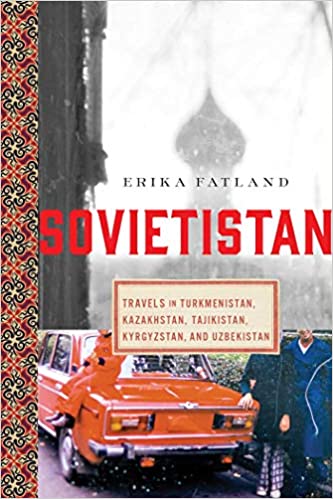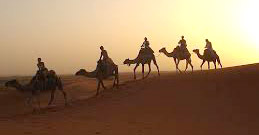For as long as I can remember, I have been fascinated by the Silk Road. Before adoption of the magnetic compass and advances in ship design in the early 1500s, this overland journey, also known as the Spice Road, served as the main trade route between China and Europe.
Visions of camel caravans crossing the dry deserts and snow-capped mountains of Central Asia captured my imagination. I longed to travel along this exotic route. I don’t know where my interest in the “Stans” (those mysterious countries along the Silk Road) originated. Was it my early interest in China, my first visit to Venice as a teenager, the exciting tales of Marco Polo, or Michener’s novel, Caravans, which I read in the mid-1960s?
As described in my travel memoir, Wherever the Road Leads, Afghanistan was a highlight of our two-year adventure. But Afghanistan, a turbulent nation now so much a part of our current news, lies south of the actual Silk Road. In 2001, Tom and I had signed up for an Elderhostel (Road Scholar) trip to Uzbekistan, Tajikistan, Kyrgyzstan, and Turkmenistan. We were to travel there after a trip to China. Unfortunately, the Silk Road portion of the trip was cancelled due to upheavals in the region. Uzbekistan was experiencing a build-up of US troops after 9/11 as the U.S. prepared to invade Taliban held Afghanistan. The tour organization deemed it unsafe to travel in the “Stans” and our opportunity was lost.
Recently, I have become an “armchair” traveler to Central Asia as I read four books about travel along the Silk Road.
 Last spring, my interest was rekindled by Apples Are From Kazakhstan, a travel memoir by a British journalist, Christopher Robbins. He became intrigued by Kazakhstan after an airplane conversation with an American on his way there to marry an Internet bride. In Robbins’ book, in-depth research is coupled with personal stories of his travels throughout Kazakhstan. The book fully discusses the country’s Soviet period, as well as the last 10 years as a democracy and its move toward modernization. Charming black and white wood-cuts by Bob Gale illustrate everything from yurts to eagles to oil wells.
Last spring, my interest was rekindled by Apples Are From Kazakhstan, a travel memoir by a British journalist, Christopher Robbins. He became intrigued by Kazakhstan after an airplane conversation with an American on his way there to marry an Internet bride. In Robbins’ book, in-depth research is coupled with personal stories of his travels throughout Kazakhstan. The book fully discusses the country’s Soviet period, as well as the last 10 years as a democracy and its move toward modernization. Charming black and white wood-cuts by Bob Gale illustrate everything from yurts to eagles to oil wells.
I’ve always loved reading books in subject matter groupings. This summer, I read the following books, one after another. If, like me, you enjoy reading about far-away lands, you might take a look at these.
Lands of Lost Borders, A Journey On The Silk Road, by Kate Harris, is the tale of the author’s bicycle journey (yes, you read that correctly — bicycle!) across China, Mongolia, Uzbekistan, Tajikistan and Kashmir. The author shares a story that discloses more than the discomforts of long, hot miles crossing the desert, painful saddle-sores, and sleeping in a tent or in third-rate guest-houses. Harris also discusses the history of the area, her interest in a variety of previous explorers (especially women), her personal reasons for preferring this type of travel, risky and illegal border crossings, and the look and feel of various towns and cities. Kate and her companion, Mel (her best friend from High School), sometimes resorted to loading themselves and their bikes onto cross-country trains, but mainly they pedaled the entire trip.
journey (yes, you read that correctly — bicycle!) across China, Mongolia, Uzbekistan, Tajikistan and Kashmir. The author shares a story that discloses more than the discomforts of long, hot miles crossing the desert, painful saddle-sores, and sleeping in a tent or in third-rate guest-houses. Harris also discusses the history of the area, her interest in a variety of previous explorers (especially women), her personal reasons for preferring this type of travel, risky and illegal border crossings, and the look and feel of various towns and cities. Kate and her companion, Mel (her best friend from High School), sometimes resorted to loading themselves and their bikes onto cross-country trains, but mainly they pedaled the entire trip.
The idea of riding a bicycle on such a torturous route sounds like a living nightmare to me. Still the book was interesting.
Stans By Me: A whirlwind tour through Central Asia – Kazakhstan, Kyrgyzstan, Tajikistan, Turkmenistan and Uzbekistan, is a memoir about a more conventional journey.  Ged Gillmore, a Brit turned Aussie, crime-fiction writer, recounts his story with a generous serving of deadpan British wit. After several days exploring Uzbekistan with a guide, Gillmore joins an organized tour, billed as “Five Stans in Ten Days.” Usually an independent traveler, Gillmore is terrified of joining a tour, but soon finds that the experiences he dreaded are perfect fodder for his humor.
Ged Gillmore, a Brit turned Aussie, crime-fiction writer, recounts his story with a generous serving of deadpan British wit. After several days exploring Uzbekistan with a guide, Gillmore joins an organized tour, billed as “Five Stans in Ten Days.” Usually an independent traveler, Gillmore is terrified of joining a tour, but soon finds that the experiences he dreaded are perfect fodder for his humor.
An enjoyable read, Stans By Me is a “once over lightly” tour of the region. Readers will share Ged’s joy seeing stark landscapes and ancient citadels, learn about still practiced rituals such as goat-pulling and bride-stealing, and visit bejeweled cities. At the end of the book, Gillmore inexplicably declares his memoir to be a novel. I think he changed the personalities, names and actions of his travel companions so much (for reasons of privacy and humor) that the memoir became, in his mind, fiction. The word portraits of Ged’s travel friends are lively and biting.
Sovietistan, longer than the others at 470 pages, is also arguably the best. The author, a Norwegian journalist, Erika Flatland, covers the five “Stans” in detail, one at a time. Each section begins with a map and a few statistics. Then Erika, writes in stunning prose about the overlapping history of each nation, as well as her personal experiences traveling there. I read the book in English, translated from the Norwegian by Kari Dickson.
Erika Flatland, covers the five “Stans” in detail, one at a time. Each section begins with a map and a few statistics. Then Erika, writes in stunning prose about the overlapping history of each nation, as well as her personal experiences traveling there. I read the book in English, translated from the Norwegian by Kari Dickson.
Flatland, who was trained as a social anthropologist, speaks eight languages, including Russian. Because the “Stans” were part of the Soviet Union from the 1870s until 1991, Russian is still spoken by many in region. Thus, Erika was able to interview local people herself, without the help of a translator. She describes the natural beauty, customs, economies, and political ups and downs of each country. Her extensive knowledge allows her to draw parallels and point out differences, but it is her story-telling ability that holds the reader’s interest page after page. Just when you begin to think you’ve had enough history and geography, Erika offers a glimpse into a remote valley or a local festival. When the author talks directly to people along the way, wonderful insights into their personal lives and day to day struggles emerge.
One of these fascinating chapters deals with the tradition of bride-stealing, still routinely practiced in Kyrgyzstan. Even modern, educated, young women starting careers in the city are kidnapped by men from the villages. This endeavor is supported by the boy’s family and friends, often even by the family of the girl. Though outlawed, the practice continues and few girls have the will to resist. They know they will be ostracized if they do. Certainly, this women’s rights issue needs more western exposure.
After reading so much about Central Asia recently, I still long to go there. But now, my enthusiasm is tempered by additional knowledge. I have a better idea of where I would want to go and which cities or countries I might choose to skip. Unfortunately, I feel this may be a trip more for the young than for a traveler who is rapidly approaching eighty. But, I can still dream. For the time being I will remain an armchair-traveler to the “Stans.”
What is the dream trip you long to take? What is your favorite arm-chair travel destination? Please share your answers in the “Leave a Reply” form below.
Sign up to receive the latest news, events and personal insights from Katie Lang‑Slattery.

Leave a Reply